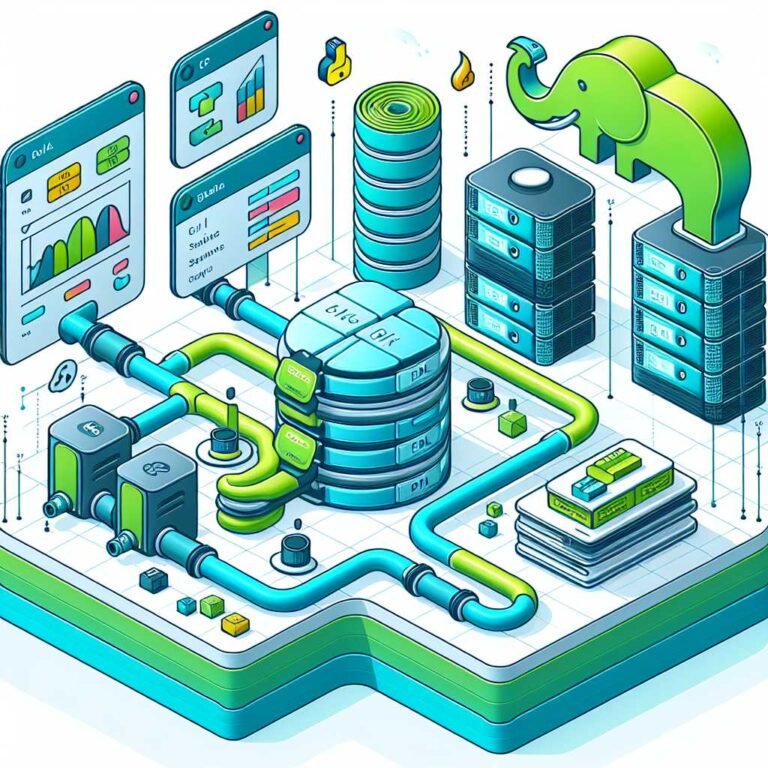Data Engineering Blueprint for 2025: Build Scalable Pipelines with Apache Spark, Airflow, and Cloud Databases
If you’ve ever watched an overnight data job crawl past sunrise—or found out a critical dashboard was stale right before a board meeting—you know the pain of brittle pipelines. The truth is, as data volume, velocity, and variety explode, duct-taped scripts just can’t keep up. You need a blueprint. You need a system that turns raw data into reliable insight, day after day, even when requirements shift, traffic spikes, and edge cases pile up.
That’s where a modern approach to data engineering comes in. Data Engineering Blueprint: Building Robust Pipelines for Big Data by Don Liatt distills the playbook for building production-grade data systems with Apache Spark, Apache Airflow, and cloud data warehouses like Amazon Redshift, Google BigQuery, and Snowflake. Updated for 2025 and packed with realistic examples, it bridges the gap between “it works on my laptop” and “it runs flawlessly at 2 a.m.” Let me explain why these tools—and the way you combine them—matter more than ever.
What “robust” really means in data engineering
Robust doesn’t mean “it worked once.” It means the job is predictable, resilient, observable, and easy to change. In practice, that looks like:
- Reliability: The pipeline hits SLAs even with skewed data or flaky network calls.
- Idempotency: Reruns won’t double-count or corrupt downstream tables.
- Observability: You can answer “What failed, why, and where?” in minutes.
- Scalability: More data should mean more compute, not missed deadlines.
- Security and governance: Access is least-privilege, lineage is traceable, and data is compliant by design.
Here’s why that matters: reliable data earns trust, and trusted data gets used. If analysts fear your numbers, they will quietly build shadow pipelines, and your team’s influence drops.
Curious if the full playbook is worth it for your team? Check it on Amazon.
Core foundations: ETL vs. ELT, batch vs. streaming, and scaling principles
Before diving into tools, align on the fundamentals:
- ETL vs. ELT: With cloud warehouses and lakehouses, ELT (load raw, then transform) often wins for agility and cost. But classic ETL still makes sense for heavy preprocessing or PII tokenization before storage.
- Batch vs. streaming: Batch is simpler and powerful for periodic reporting; streaming shines when latency matters (fraud detection, real-time recommendations). Many real systems are hybrid: streaming for hot paths, batch for reprocessing and backfill.
- Data contracts and schemas: Treat schemas as a product. Define contracts between producers and consumers to prevent breaking changes.
- Partitioning, file formats, and compression: Store data in columnar formats like Apache Parquet and partition by common filters (e.g., date, region) to reduce scan costs. Avoid the small-files problem to keep Spark and warehouses fast.
- Governance and privacy: Build with auditability in mind. Pseudonymize sensitive attributes early; document lineage and access.
This foundation prevents painful rewrites when your pipeline scales from gigabytes to terabytes.
Mastering Apache Spark at scale
Apache Spark is the engine that processes massive datasets and powers both batch and streaming pipelines. But getting the most from Spark requires a few tactical skills.
Spark SQL and DataFrames: Write logic the optimizer understands
DataFrames aren’t just convenient—they’re the path to efficient execution via the Catalyst optimizer. Favor transformations that push computation down to data sources and avoid using UDFs unless needed (they’re often black boxes to the optimizer).
- Cache with intent: Cache only reused intermediate results; unpersist aggressively.
- Skew and shuffle: Watch out for wide transformations (joins, groupBy) that trigger expensive shuffles. Use broadcast joins for small dimension tables and salting techniques to handle skewed keys.
- Partitioning: Repartition before large joins to balance work; coalesce when writing fewer large files.
Ready to level up with guided Spark labs? See price on Amazon.
Structured Streaming: When “almost now” is good enough
Structured Streaming makes streaming feel like incremental batch. You define transformations once and Spark maintains state across micro-batches.
- Triggers and checkpointing: Use checkpoints to handle failures and restart cleanly.
- Exactly-once semantics: Combine idempotent sinks and deterministic keys to avoid duplicates downstream.
- Watermarks: Use watermarks to bound the state for late-arriving data, preventing unbounded memory growth.
For ingestion, pair Spark with Apache Kafka for durable, scalable event logs. Keep topic partition counts healthy to maximize parallelism.
MLlib and feature pipelines
Spark MLlib supports feature engineering and distributed training, but many teams now train models elsewhere and use Spark for feature computation and batch scoring. That’s fine—optimize the pipeline around your model lifecycle, not vice versa.
Orchestrating workflows with Apache Airflow
Apache Airflow is the scheduler and orchestrator that turns your scripts into production-grade workflows. The key is to design Directed Acyclic Graphs (DAGs) that are fault-tolerant and observable.
- Task boundaries: Smaller, single-purpose tasks are easier to retry and debug.
- Idempotency: Make tasks safe to rerun. Use checkpoints, atomic writes, and transactional merges in your data warehouse.
- Retries and SLAs: Configure retries with exponential backoff. Use SLAs and alerts to detect late or failing tasks quickly.
- Sensors and deferrable operators: Reduce resource waste by using deferrable sensors and event-driven scheduling.
- Dynamic task mapping: Fan out tasks based on metadata or partitions without hard-coding each task.
- Backfills: Treat backfills as first-class citizens; version transformations and ensure historical reruns produce consistent results.
Integrate Airflow with external services through hooks—Kafka for ingestion, Spark clusters for compute, and cloud warehouses for storage—to build a coherent pipeline that’s traceable end to end.
Choosing the right cloud database: Redshift vs. BigQuery vs. Snowflake
Your serving layer makes or breaks user experience. Each of the big three cloud data warehouses (or “lakehouse” platforms) has strengths:
- Amazon Redshift: Great for teams already deep in AWS, solid performance with RA3 nodes and Redshift Spectrum for lake integration. AWS Redshift.
- Google BigQuery: Serverless with on-demand or flat-rate pricing, excellent for ad-hoc analytics at scale and built-in ML features. Google BigQuery.
- Snowflake: Separation of storage and compute, elastic warehouses, and powerful features like Time Travel and zero-copy cloning. Snowflake.
A quick decision frame:
- Data model: Star schemas and materialized views fit all three; BigQuery’s partitioned and clustered tables can be very cost-effective for selective queries.
- Latency vs. throughput: BigQuery shines for interactive exploration; Snowflake balances elasticity with predictable performance; Redshift can deliver high throughput with thoughtful sort keys and distribution styles.
- Pricing model: Understand cost drivers. BigQuery charges per scanned byte (optimize partitioning and clustering). Snowflake charges per-credit runtime (scale warehouses up/down). Redshift’s managed cluster cost is tied to node types and hours.
- Ecosystem fit: Choose the one that integrates best with your security model, IAM, networking, and BI tools.
If you’re buying for a team and want practical worksheets for estimating cost and workload fit, View on Amazon.
Schema design and performance tips that pay off
- Partition by common filters (e.g., event_date) and cluster by high-cardinality columns frequently used in WHERE and ORDER BY.
- Store raw and curated layers separately. Raw for compliance and replay; curated for trustworthy analytics.
- Use a medallion architecture (bronze, silver, gold) to make data quality explicit.
- Adopt column-level lineage and tags so compliance and discovery aren’t afterthoughts.
Hands-on projects that mirror real teams
Theory is great, but nothing beats realistic practice. The projects in Data Engineering Blueprint mirror what high-performing teams do:
- Sales analytics with Spark: Build a DataFrame-based pipeline that ingests, dedupes, standardizes currency, and aggregates by cohort.
- E-commerce pipeline in Airflow: Orchestrate ingestion from Kafka, transform with Spark on a cluster, and load into BigQuery for dashboards.
- End-to-end streaming analytics: Process clickstream events in near real time, enrich with dimension data, maintain stateful metrics, and power a recommendations endpoint updated every few minutes.
- Financial reporting: Enforce strict data contracts, audit trails, and reconciliation checks using Great Expectations.
Want a checklist you can run tomorrow morning? Shop on Amazon.
Testing, data quality, and observability
There’s no robustness without testing and monitoring. Build them in from day one.
- Unit and integration tests: Use PyTest to validate transformations and schema assumptions. Mock external services to keep tests fast and deterministic.
- Data quality with Great Expectations: Declaratively assert expectations on null rates, uniqueness, ranges, and referential integrity. See Great Expectations.
- Contract tests: If upstreams change, you should know before prod breaks. Validate payloads against agreed contracts.
- Metrics and alerts: Export pipeline metrics (latency, throughput, error rates) to Prometheus and visualize in Grafana.
- Lineage and metadata: Adopt OpenLineage or similar standards to trace data across jobs and tools. Explore OpenLineage.
Aim for “mean time to recovery” measured in minutes, not hours.
Performance tuning and cost governance
Performance without cost control is a budget bomb. Both need attention.
- File layout: Use Parquet with snappy or zstd compression; write fewer, larger files to minimize overhead. Compact small files on a schedule.
- Pruning and pushdown: Make filters sargable; avoid transformations that block partition pruning.
- Join strategies: Broadcast small tables; pre-aggregate where possible; beware UDFs that force row-by-row logic.
- Autoscaling and right-sizing: Scale Spark executors based on stage behavior. In warehouses, right-size compute clusters and sleep them when idle.
- Caching and materialization: Materialize hot aggregates; invalidate and refresh on a schedule rather than recomputing everything.
- Cost visibility: Tag workloads by owner and project. Review cost dashboards weekly. Practice kill-switch discipline for runaway jobs.
If you prefer a curated roadmap with templates and diagrams, Buy on Amazon.
Future-proofing: data lakes, lakehouses, serverless, and AI-driven automation
Architectures evolve. Design with the next two years in mind.
- Data lake and lakehouse: Keep your data in open formats and table specs like Delta Lake, Apache Iceberg, or Apache Hudi. Lakehouse patterns merge flexible storage with warehouse-style management.
- Serverless processing: Services like AWS Glue and Google Dataflow reduce ops burden and scale dynamically.
- AI-assisted pipelines: Expect smarter anomaly detection, auto-scaling, and even automated query optimization. Human-in-the-loop remains key, but automation will catch more issues before you wake up.
- Privacy and ethics by design: Build consent-aware data flows. Minimize and anonymize sensitive attributes, and audit access logs routinely.
This is how you avoid hard rewrites when your use cases—or leadership priorities—shift.
Common pitfalls and how to dodge them
- Treating Airflow as a data bus: Keep heavy data movement in Spark or managed services; use Airflow to orchestrate, not transfer gigabytes.
- Ignoring backfills: Design transformations to be rerunnable historically without silent drift.
- Neglecting small files: Many “Spark is slow” complaints trace back to small file fragmentation.
- Overusing UDFs: They feel handy but can nuke optimizations. Reach for built-in functions first.
- Cost blindness: Track cost per job and per dashboard. Tie spend to business outcomes.
A pragmatic learning path that sticks
If you’re starting from zero or leveling up from “script wrangler” to “system designer,” here’s a sequence that works:
- Foundations: Learn schemas, partitioning, and the ELT mindset.
- Spark: DataFrames, joins, skew handling, and Structured Streaming basics.
- Airflow: DAG design, retries, backfills, and dynamic task mapping.
- Warehouse: Choose one (Redshift, BigQuery, Snowflake) and get fluent in its performance knobs.
- Quality and monitoring: Add Great Expectations and Prometheus/Grafana.
- Projects: Ship a small end-to-end pipeline in prod; learn from real incidents.
- Scale: Optimize for cost and speed; add lakehouse patterns where they fit.
Ready for a structured, practice-first guide that follows this arc? See price on Amazon.
Real-world case studies: what success looks like
- Streaming analytics like Netflix-inspired clickstream: Ingest millions of events via Kafka, enrich with user features, compute rolling engagement metrics in Spark Structured Streaming, and land to BigQuery for near-real-time dashboards.
- Finance-grade reporting: Enforce strict schemas, idempotent merges, and double-entry checks; run Great Expectations on every layer; deliver reconciled numbers with audit trails.
- E-commerce recommendations: Batch compute features daily, update top-N recommendations every few minutes with streaming deltas, and serve through a warehouse-backed API or a feature store.
These patterns repeat across industries. The tech changes; the goals—reliability, clarity, speed—don’t.
Conclusion: Build once, trust always
Robust data pipelines aren’t magic—they’re the compound result of good choices: clear contracts, right tools, and habits like testing and observability. When you pair Spark’s horsepower, Airflow’s orchestration, and a well-chosen cloud warehouse with disciplined engineering, you get systems that ship insight on time, every time. If this helped, subscribe for more hands-on guides and breakdowns of the tools shaping modern data teams.
FAQ
What is Apache Spark used for in data engineering?
Spark powers large-scale data processing. Teams use it for ETL/ELT, joins and aggregations over huge datasets, streaming with Structured Streaming, and batch scoring for machine learning. It’s faster than plain MapReduce and has rich APIs for SQL, Python, and Scala.
When should I use batch vs. streaming pipelines?
Use batch for periodic reporting, dimensional modeling, and heavy reprocessing. Use streaming when latency matters (fraud detection, live metrics, operational dashboards). Many systems are hybrid: streaming for hot paths and batch for corrections and backfills.
Is Airflow still relevant with serverless tools?
Yes. Even with serverless compute, you need orchestration, dependencies, retries, and observability. Airflow coordinates tasks across services, enforces schedules and SLAs, and provides a control plane for your data platform.
How do I choose between Redshift, BigQuery, and Snowflake?
Choose based on ecosystem fit, pricing model, latency needs, and your team’s skills. BigQuery is strong for ad-hoc analysis at scale with serverless convenience. Snowflake excels in elasticity and features like Time Travel. Redshift fits AWS-heavy shops and can be very cost-effective when tuned.
What’s the “small files problem” and how do I avoid it?
Many tiny files cause high overhead in Spark and warehouses. Write larger, well-partitioned Parquet files, compact output on a schedule, and control parallelism to produce optimal file sizes.
How do I ensure data quality in production?
Adopt expectations-based testing with tools like Great Expectations, add schema and contract checks, and monitor data drifts with dashboards and alerts. Make every pipeline stage observable and fail fast on unexpected input.
What’s a lakehouse and do I need one?
A lakehouse blends data lake flexibility with warehouse features like ACID transactions and schema enforcement using table formats like Delta Lake, Iceberg, or Hudi. You don’t need one to start, but it helps when you want open storage with reliable table semantics and streaming-friendly workflows.
Discover more at InnoVirtuoso.com
I would love some feedback on my writing so if you have any, please don’t hesitate to leave a comment around here or in any platforms that is convenient for you.
For more on tech and other topics, explore InnoVirtuoso.com anytime. Subscribe to my newsletter and join our growing community—we’ll create something magical together. I promise, it’ll never be boring!
Stay updated with the latest news—subscribe to our newsletter today!
Thank you all—wishing you an amazing day ahead!
Read more related Articles at InnoVirtuoso
- How to Completely Turn Off Google AI on Your Android Phone
- The Best AI Jokes of the Month: February Edition
- Introducing SpoofDPI: Bypassing Deep Packet Inspection
- Getting Started with shadps4: Your Guide to the PlayStation 4 Emulator
- Sophos Pricing in 2025: A Guide to Intercept X Endpoint Protection
- The Essential Requirements for Augmented Reality: A Comprehensive Guide
- Harvard: A Legacy of Achievements and a Path Towards the Future
- Unlocking the Secrets of Prompt Engineering: 5 Must-Read Books That Will Revolutionize You







